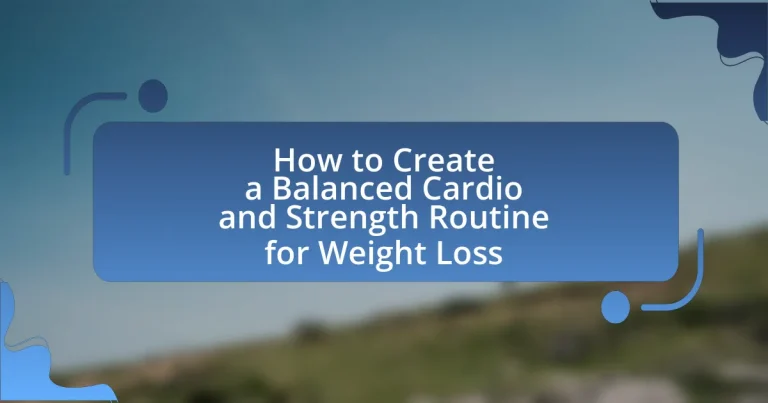A balanced cardio and strength routine for weight loss combines aerobic exercises and resistance training, aiming for at least 150 minutes of moderate-intensity cardio weekly alongside two to three days of strength training. This approach enhances fat loss while preserving lean muscle mass, as supported by research from the American College of Sports Medicine. Key components include various cardio activities like running and cycling, and strength exercises such as weightlifting and bodyweight workouts. The article outlines how to create a personalized routine, the importance of balance, and strategies for maintaining motivation and overcoming challenges in achieving weight loss goals.

What is a Balanced Cardio and Strength Routine for Weight Loss?
A balanced cardio and strength routine for weight loss includes a combination of aerobic exercises and resistance training, typically structured to include at least 150 minutes of moderate-intensity cardio per week alongside two to three days of strength training. This approach effectively promotes fat loss while preserving lean muscle mass, as supported by research from the American College of Sports Medicine, which emphasizes the importance of both exercise types for optimal weight management. Cardio exercises, such as running or cycling, elevate heart rate and burn calories, while strength training, including weight lifting or bodyweight exercises, enhances metabolism and builds muscle, leading to increased calorie expenditure even at rest.
How does a balanced routine contribute to weight loss?
A balanced routine contributes to weight loss by combining cardiovascular exercise and strength training, which together enhance calorie burning and muscle preservation. Cardiovascular activities, such as running or cycling, increase heart rate and promote fat loss, while strength training builds lean muscle mass, which boosts metabolism. Research indicates that individuals who engage in both types of exercise can achieve greater weight loss results compared to those who focus on only one. For instance, a study published in the Journal of Obesity found that participants who followed a combined cardio and strength training program lost more body fat and maintained muscle compared to those who did cardio alone. This synergy between the two forms of exercise maximizes energy expenditure and supports sustainable weight management.
What are the key components of cardio and strength training?
The key components of cardio training include aerobic exercises that elevate heart rate, such as running, cycling, and swimming, which improve cardiovascular endurance and burn calories. Strength training focuses on resistance exercises, like weight lifting and bodyweight workouts, that build muscle mass, enhance metabolism, and increase overall strength. Research indicates that combining both cardio and strength training optimizes weight loss and improves body composition, as evidenced by a study published in the Journal of Obesity, which found that individuals who engaged in both types of training lost more weight and maintained muscle mass compared to those who focused solely on one type.
How do cardio and strength training complement each other?
Cardio and strength training complement each other by enhancing overall fitness and promoting effective weight loss. Cardio exercises, such as running or cycling, improve cardiovascular health and increase calorie expenditure, while strength training builds muscle mass, which boosts metabolism and aids in fat loss. Research indicates that combining both forms of exercise leads to greater fat loss compared to either type alone, as evidenced by a study published in the Journal of Obesity, which found that individuals who engaged in both cardio and strength training lost more weight and maintained muscle mass better than those who focused solely on one type of exercise. This synergy allows individuals to achieve a balanced fitness routine that maximizes weight loss and improves body composition.
Why is it important to balance cardio and strength training?
Balancing cardio and strength training is important because it optimizes overall fitness and enhances weight loss. Cardio exercises, such as running or cycling, improve cardiovascular health and increase calorie burn, while strength training builds muscle mass, which boosts metabolism. Research indicates that individuals who incorporate both types of exercise experience greater fat loss and improved body composition compared to those who focus on only one type. A study published in the Journal of Applied Physiology found that combining aerobic and resistance training leads to more significant reductions in body fat and increases in lean muscle mass, supporting the effectiveness of a balanced routine for weight loss.
What are the risks of focusing too much on one type of exercise?
Focusing too much on one type of exercise increases the risk of overuse injuries, muscle imbalances, and decreased overall fitness. Overuse injuries occur when repetitive stress is placed on the same muscles and joints without adequate recovery, leading to conditions such as tendonitis or stress fractures. Muscle imbalances arise when certain muscle groups are overdeveloped while others are neglected, potentially resulting in poor posture and increased injury risk. Additionally, concentrating solely on one exercise type can limit cardiovascular or strength development, hindering overall fitness progress. Research indicates that a balanced routine incorporating various exercise modalities is essential for optimal health and performance.
How does balance affect metabolism and fat loss?
Balance significantly affects metabolism and fat loss by optimizing energy expenditure and nutrient utilization. A well-balanced routine that incorporates both cardio and strength training enhances metabolic rate, as strength training builds muscle mass, which in turn increases resting metabolic rate. Research indicates that individuals who engage in a combination of aerobic and resistance exercises experience greater fat loss compared to those who focus solely on one type of exercise. For instance, a study published in the Journal of Applied Physiology found that participants who performed both cardio and strength training lost more body fat and maintained lean muscle mass more effectively than those who did only cardio. This evidence underscores the importance of balance in exercise routines for maximizing metabolism and promoting fat loss.
What are the different types of cardio and strength exercises?
Cardio exercises include running, cycling, swimming, and rowing, while strength exercises encompass weightlifting, resistance band workouts, bodyweight exercises, and Pilates. Cardio exercises primarily aim to improve cardiovascular endurance and burn calories, with running being one of the most effective forms, as it can burn approximately 600 calories per hour for a 155-pound individual. Strength exercises focus on building muscle mass and increasing strength, with weightlifting being a key method, as it can enhance muscle strength and metabolism, contributing to weight loss.
What are the most effective cardio exercises for weight loss?
High-intensity interval training (HIIT), running, cycling, and swimming are the most effective cardio exercises for weight loss. HIIT combines short bursts of intense activity with rest or low-intensity periods, leading to increased calorie burn and improved metabolic rate. Studies show that HIIT can burn 25-30% more calories than traditional steady-state cardio in the same amount of time. Running is a high-impact exercise that can burn approximately 600 calories per hour, depending on speed and body weight. Cycling, whether stationary or outdoor, can burn around 500-1000 calories per hour, making it an efficient choice for weight loss. Swimming engages multiple muscle groups and can burn about 400-700 calories per hour, depending on the stroke and intensity. These exercises not only promote weight loss but also enhance cardiovascular health and overall fitness.
Which strength training exercises are best for beginners?
The best strength training exercises for beginners include bodyweight squats, push-ups, lunges, and dumbbell rows. These exercises are effective because they target multiple muscle groups, promote functional strength, and can be performed with minimal equipment. Bodyweight squats engage the legs and core, push-ups strengthen the chest and arms, lunges work the lower body, and dumbbell rows target the back and arms. According to the American College of Sports Medicine, incorporating these foundational movements helps beginners build strength safely and effectively, laying the groundwork for more advanced exercises in the future.

How can you create a personalized cardio and strength routine?
To create a personalized cardio and strength routine, first assess your fitness level, goals, and preferences. This involves determining your current physical condition, identifying specific weight loss targets, and selecting activities you enjoy, which increases adherence. Next, design a balanced schedule that incorporates both cardio and strength training, aiming for at least 150 minutes of moderate-intensity cardio and two days of strength training per week, as recommended by the American Heart Association. Finally, regularly evaluate and adjust your routine based on progress and changing goals to ensure continued effectiveness and motivation.
What factors should you consider when designing your routine?
When designing your routine for weight loss, consider the balance between cardio and strength training. A well-rounded approach typically includes 150 minutes of moderate-intensity aerobic activity per week, as recommended by the American Heart Association, combined with at least two days of strength training targeting major muscle groups. Additionally, assess your fitness level, personal goals, available time, and any physical limitations to tailor the routine effectively. Research indicates that incorporating both types of exercise can enhance fat loss and improve overall health, making it essential to find a sustainable balance that fits individual lifestyles.
How do your fitness level and goals influence your routine?
Your fitness level and goals significantly shape your routine by determining the intensity, duration, and type of exercises you incorporate. For instance, individuals with a higher fitness level may engage in more advanced strength training and high-intensity cardio, while beginners might focus on foundational exercises and moderate cardio to build endurance. Additionally, specific goals such as weight loss require a balanced approach that combines both cardio and strength training; research indicates that a combination of these elements can enhance fat loss and improve overall fitness (American College of Sports Medicine, 2018). Thus, tailoring your routine based on your current fitness level and desired outcomes is essential for effective progress.
What role does time commitment play in your routine design?
Time commitment is crucial in routine design as it determines the frequency, duration, and intensity of workouts. A well-structured routine requires a realistic assessment of available time to ensure consistency and effectiveness in achieving weight loss goals. For instance, research indicates that individuals who allocate specific time slots for exercise are more likely to adhere to their routines, leading to better outcomes in weight management. Therefore, understanding and committing to a time frame enhances the likelihood of successfully integrating both cardio and strength training into a balanced routine.
How can you structure your weekly workout schedule?
To structure your weekly workout schedule, allocate specific days for cardio and strength training, ensuring a balanced approach. For example, designate three days for strength training, focusing on different muscle groups each session, and two to three days for cardiovascular exercises, such as running or cycling. This method allows for muscle recovery while maintaining cardiovascular fitness. Research indicates that combining strength and cardio can enhance weight loss and improve overall fitness levels, as supported by a study published in the Journal of Obesity, which found that individuals who engaged in both types of exercise experienced greater fat loss compared to those who focused solely on one type.
What is the ideal frequency for cardio and strength training?
The ideal frequency for cardio training is 150 to 300 minutes per week, while strength training should be performed at least two days per week. This recommendation is supported by the American Heart Association and the Centers for Disease Control and Prevention, which emphasize that engaging in moderate-intensity aerobic activity for 150 minutes weekly can improve cardiovascular health and aid in weight loss. Additionally, incorporating strength training on two or more days enhances muscle mass and metabolism, further contributing to effective weight management.
How can you incorporate rest days effectively?
Incorporating rest days effectively involves scheduling them strategically within your workout routine to allow for muscle recovery and prevent overtraining. Research indicates that rest days are essential for muscle repair, growth, and overall performance enhancement, as they help reduce the risk of injury and fatigue. For optimal results, plan rest days after intense workout sessions, ensuring at least one to two rest days per week, depending on your training intensity and volume. This approach aligns with guidelines from the American College of Sports Medicine, which recommends varying intensity and including recovery periods to maximize fitness gains.

What are some tips for maintaining motivation and consistency?
To maintain motivation and consistency in a balanced cardio and strength routine for weight loss, set clear, achievable goals. Research indicates that specific and measurable goals enhance commitment; for instance, a study published in the Journal of Sport & Exercise Psychology found that individuals with defined objectives are more likely to adhere to their fitness plans. Additionally, tracking progress through journals or apps reinforces accountability and provides visual evidence of improvement, which can boost motivation. Establishing a routine by scheduling workouts at the same time each day helps create a habit, making it easier to stay consistent. Lastly, incorporating variety in workouts prevents boredom and keeps engagement high, as supported by findings in the International Journal of Behavioral Nutrition and Physical Activity, which suggest that diverse exercise regimens lead to higher adherence rates.
How can you track your progress effectively?
To track your progress effectively, utilize a combination of measurable metrics, such as weight, body measurements, and workout performance. Regularly recording your weight and taking body measurements, like waist and hip circumference, provides tangible evidence of changes over time. Additionally, tracking workout performance, including the number of repetitions, weights lifted, and duration of cardio sessions, allows for assessment of strength and endurance improvements. Research indicates that individuals who consistently monitor their progress are more likely to achieve their fitness goals, as they can adjust their routines based on data-driven insights.
What tools or apps can help you monitor your workouts?
Fitness tracking apps and tools such as MyFitnessPal, Fitbit, Strava, and Apple Health can effectively monitor workouts. MyFitnessPal allows users to log exercises and track caloric intake, while Fitbit provides detailed metrics on heart rate, steps, and activity levels. Strava is popular among runners and cyclists for tracking distance and pace, and Apple Health aggregates data from various fitness apps and devices to give a comprehensive overview of health metrics. These tools utilize GPS and sensors to provide accurate data, enhancing workout monitoring and helping users achieve their fitness goals.
How does setting realistic goals enhance motivation?
Setting realistic goals enhances motivation by providing achievable benchmarks that individuals can strive for, leading to a sense of accomplishment. When goals are realistic, they align with an individual’s current abilities and resources, making it more likely for them to experience success. Research indicates that specific and attainable goals can increase motivation by up to 90%, as individuals are more likely to remain engaged when they see progress. This sense of progress reinforces their commitment to the routine, ultimately fostering a positive feedback loop that sustains motivation over time.
What common challenges might you face and how can you overcome them?
Common challenges in creating a balanced cardio and strength routine for weight loss include time management, motivation, and balancing intensity. To overcome time management issues, individuals can schedule workouts in advance and prioritize them as essential appointments, ensuring consistency. Motivation can be bolstered by setting specific, achievable goals and tracking progress, which has been shown to enhance adherence to exercise programs. Balancing intensity can be addressed by incorporating a mix of high-intensity interval training (HIIT) and moderate-intensity steady-state cardio, as research indicates that varied intensity can optimize fat loss while preventing burnout.
How can you deal with plateaus in weight loss?
To deal with plateaus in weight loss, individuals should adjust their diet and exercise routines. This can include increasing the intensity or duration of workouts, incorporating strength training, and modifying caloric intake to create a new deficit. Research indicates that varying exercise routines can stimulate metabolism and promote further weight loss, as shown in a study published in the Journal of Obesity, which found that participants who changed their workout regimens experienced greater weight loss than those who maintained the same routine.
What strategies can help you stay committed to your routine?
To stay committed to your routine, establish clear goals and track your progress. Setting specific, measurable, achievable, relevant, and time-bound (SMART) goals enhances motivation and accountability. Research indicates that individuals who set goals are more likely to achieve them; a study published in the American Journal of Lifestyle Medicine found that goal-setting significantly improves adherence to exercise programs. Additionally, creating a schedule and incorporating variety into workouts can prevent boredom and maintain engagement, further supporting commitment to a balanced cardio and strength routine for weight loss.
What are some best practices for a balanced cardio and strength routine?
A balanced cardio and strength routine should include a combination of aerobic exercises and resistance training, ideally performed at least three times a week for each type. Incorporating both elements enhances overall fitness, promotes fat loss, and builds muscle. Research indicates that combining cardio with strength training can lead to greater weight loss and improved body composition compared to either method alone. For instance, a study published in the Journal of Applied Physiology found that participants who engaged in both cardio and strength training lost more fat and maintained muscle mass better than those who focused solely on one type of exercise. Additionally, varying the intensity and duration of workouts, such as including high-intensity interval training (HIIT) for cardio and compound movements for strength, can optimize results and prevent plateaus.


